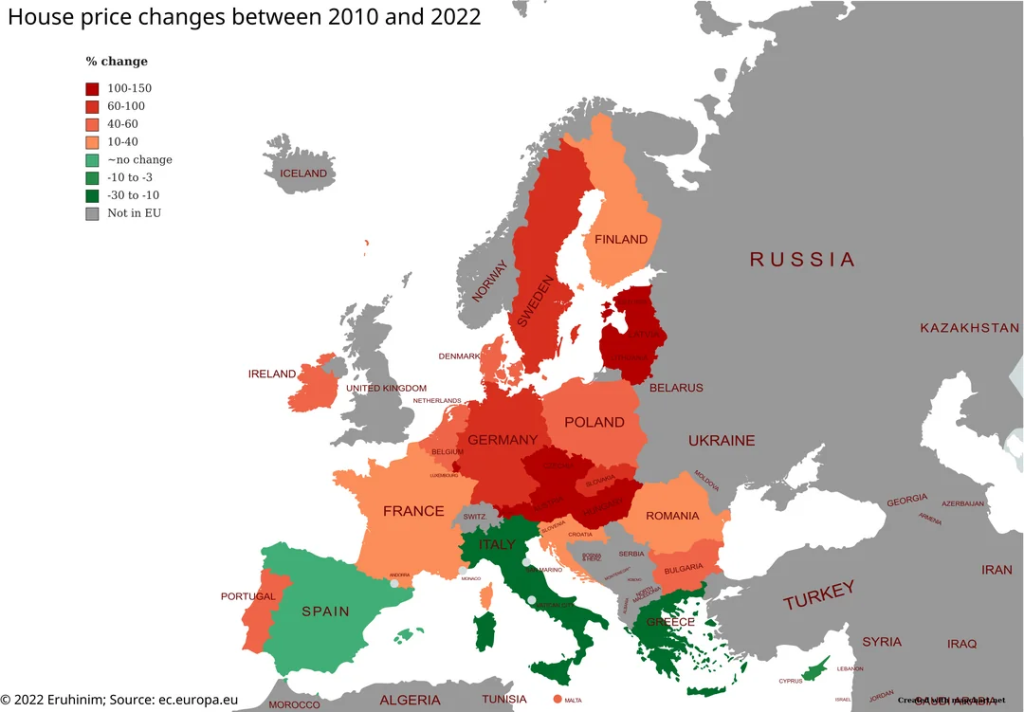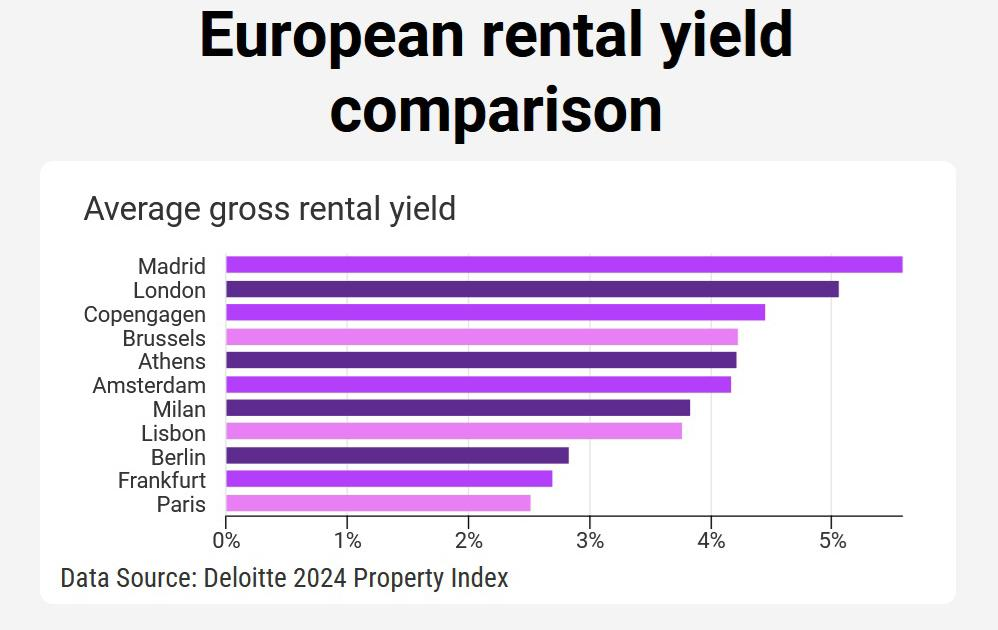Local (European-Specific) Content: Analyzing Real Estate Markets in Europe
Lesson Learning Objectives:
- Assess the impact of economic indicators like GDP growth and inflation on real estate values, understanding how these factors signal the financial health and investment potential of various European markets.
- Examine market trends and demand in different regions, focusing on how urbanization, population growth, and immigration influence real estate prices and rental demand.
- Understand the regulatory environment in Europe and its effect on real estate investment, including government policies like rent control and tax incentives that can either encourage or deter investment.
- Analyze infrastructure and development impacts on real estate value, considering how accessibility and proximity to economic hubs boost property appeal.
- Evaluate the diversity and characteristics of European real estate markets, recognizing regional disparities in price trends and investment opportunities.
5B.1 Analyzing Real Estate Markets in Europe
Analyzing real estate markets is a key part of making informed investment decisions. In Europe, real estate markets vary significantly across countries and regions, influenced by factors such as economic conditions, governmental policies, and local demand-supply dynamics. Here are some key aspects to consider when analyzing European real estate markets:
- Economic Indicators
As covered in Section 5.A, the health of a real estate market often depends on local economic indicators such as GDP growth, unemployment rates, and interest rates. For instance, strong GDP growth in cities like Berlin and Paris can lead to rising property values, while high unemployment in regions like Greece can stifle demand. - Market Trends and Demand
Market demand varies widely between different regions. Urban centers such as London, Amsterdam, and Munich generally experience high demand due to job opportunities, population growth, and immigration, driving property prices higher. Conversely, rural areas in countries like Italy or Spain may experience lower demand and slower price appreciation. - Regulatory Environment
European governments heavily regulate the real estate market. For example, Germany’s rental control laws (Mietpreisbremse) limit how much landlords can charge, which can affect the profitability of rental properties. Tax incentives, such as Portugal’s Golden Visa program, encourage foreign investment by providing residency to investors. - Infrastructure and Development
Areas with strong infrastructure, such as efficient public transportation systems and proximity to commercial hubs, tend to attract more real estate investment. For example, cities like Copenhagen and Zurich have excellent infrastructure, which helps maintain high property values and demand.
Figure: House Price Changes in Europe (2010–2022)
Description:
This map illustrates the percentage change in house prices across Europe from 2010 to 2022. Countries are color-coded, with red shades indicating increases in house prices (up to 150%) and green shades indicating price declines. Notable increases are seen in Poland, Germany, and Finland, with prices rising by 60–150%. In contrast, Spain, Italy, and Greece exhibit declines or minimal growth, indicating relatively stable or depreciating housing markets. Non-EU countries, shown in gray, are excluded from the analysis. The map highlights the regional disparities in real estate market performance over the past decade.
Key Takeaways:
- Eastern and Northern Europe experienced the most significant housing price growth, with Poland, Romania, and Finland showing increases of 60–150%.
- Southern Europe, particularly Spain, Italy, and Greece, saw either declines or minimal changes, reflecting weaker real estate market performance.
- Countries like Germany and France fall in the mid-range, with moderate increases of 40–60%, suggesting stable market growth.
- The data highlights regional economic conditions and housing demand as key factors influencing price changes.
- Green-shaded countries, such as Greece and Italy, may present opportunities for affordable investments in undervalued housing markets.
Application of Information:
This map is valuable for real estate investors, economists, and policymakers to analyze housing market trends and identify regions with high growth or stability. Investors may target high-growth areas like Poland or Finland for capital appreciation, while buyers looking for affordability may consider Spain or Greece. For learners, the map demonstrates how economic policies, population dynamics, and regional factors shape housing markets.
5B.2 Analyzing a Real Estate Investment in Europe
When analyzing a specific real estate investment in Europe, there are several financial and market factors that investors need to consider:
- Property Location
Location is one of the most important factors in real estate investment. Properties in prime locations, such as city centers or business districts, typically offer higher returns due to their demand. In Barcelona, for example, properties near the city center can command significantly higher rental yields than those in suburban areas. - Rental Yield and Return on Investment (ROI)
Investors must calculate rental yield to understand the income potential of a property. In cities like Berlin and Vienna, rental yields can range between 3-6%, depending on location and property type. High yields indicate strong income potential, while lower yields may still offer value if capital appreciation prospects are strong. - Capital Appreciation Potential
Investors must assess whether the property is likely to increase in value over time. For example, areas in Lisbon have experienced rapid capital appreciation due to foreign investment and urban regeneration projects. It’s important to research future infrastructure developments and regional economic growth when evaluating long-term appreciation. - Expenses and Taxes
In Europe, real estate expenses vary by country and property type. Investors must account for property taxes, maintenance costs, and any homeowners association (HOA) fees. Additionally, tax treatment of rental income differs, with some countries like Ireland offering tax deductions on mortgage interest, while others impose higher taxes on rental income.
Figure: European Rental Yield Comparison
Description:
This bar chart compares the average gross rental yields across key European cities, with values ranging from approximately 2% to 5%. Cities like Madrid and London lead with the highest yields close to 5%, indicating strong rental income potential relative to property prices. On the other hand, cities such as Paris and Frankfurt have the lowest yields, closer to 2%, reflecting lower rental profitability or higher property costs. The chart provides insights into regional differences in rental returns, helping users evaluate the income potential of property investments in these cities.
Key Takeaways:
- Madrid and London offer the highest rental yields (~5%), making them attractive markets for income-focused investors.
- Paris and Frankfurt rank the lowest, with yields around 2%, reflecting less favorable rental income conditions.
- Cities like Copenhagen, Brussels, and Athens fall in the mid-range, offering balanced returns between high-yield and low-yield markets.
- The data highlights significant variability across European cities, underscoring the importance of location in real estate profitability.
- Rental yields are influenced by factors like demand, property prices, and local market conditions.
Application of Information:
This data is essential for real estate investors and analysts to assess rental profitability across Europe. High-yield cities like Madrid and London are ideal for maximizing income, while low-yield cities like Paris may appeal to long-term investors seeking property value appreciation. Learners can use this chart to understand the importance of rental yield metrics when evaluating real estate markets.
Key Lesson Information:
- Economic indicators such as GDP and inflation rates are crucial for understanding market conditions and forecasting property values in various European regions.
- Urban centers exhibit high demand and price resilience, particularly in major cities like London and Amsterdam, where economic activity and population growth drive real estate markets.
- Government policies significantly influence investment returns, with regulations like Germany’s Mietpreisbremse impacting rental income potential and Portugal’s Golden Visa program attracting international capital.
- Infrastructure developments often presage rising property values, making areas near major transit projects or commercial hubs particularly attractive for investment.
- Market diversity across Europe suggests the need for region-specific strategies, as investment viability can vary greatly depending on local economic and regulatory conditions.
Closing Statement:
A comprehensive analysis of real estate markets in Europe requires a multifaceted approach, considering both macroeconomic factors and local market conditions. By integrating these insights, investors and analysts can better predict market movements, identify lucrative investment opportunities, and navigate potential challenges.



